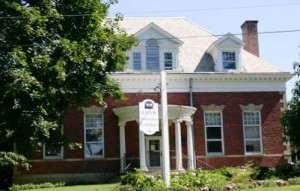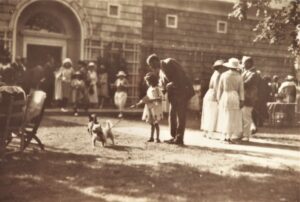‘Tea Day 1930’ by Edward Volkerts paints a beautiful picture of the teas held on the lawn in front of the Lyme Art Association in yesteryear. A ‘Tea Day’ forms part of the LAA’s Centennial celebrations this Saturday. Image published courtesy of the Volkerts family.
OLD LYME — On Saturday, Aug. 7, the Lyme Art Association (LAA) is celebrating the 100th anniversary of the opening of its gallery. Several special events are planned, one of which is a tea party on the LAA lawn.
Though the gallery itself opened in August of 1921, the history of the LAA goes even further back and is interwoven with our town library and the Florence Griswold Museum.
To start at the very beginning—in 1899, Henry Ward Ranger, already an established painter, arrived in Old Lyme and bunked down at the boardinghouse of Florence Griswold. So smitten was Ranger with the beauty of the area and the quality of the light that he began to envision the village as an American art colony.
He wrote to his agent in New York that Lyme was a landscape waiting to be painted and told Miss Florence he would be back the next summer and bring more painters with him. And so the artists came.

The Phoebe Griffin Noyes Library was the original home of the Lyme Art Colony’s summer exhibition from 1902 through 1920 before the Lyme Art Association had a building of its own.
And in 1902, the artists began a summertime tradition when they held an exhibition in the Phoebe Griffin Noyes Library. An article in the Hartford Courant explained that “the library and the artists have formed a sort of close corporation.” The library (which opened in 1898, the year before Ranger arrived) needed funds to buy books; the artists needed an exhibition space.
“One scheme after another was tried until it occurred to someone to ask the artists who spend their summers in town to exhibit some of their paintings” the Courant reporter wrote. Admission to the show was 50 cents and proceeds were for the benefit of the library. Additionally, the library received a percentage of all paintings sold.
It was the beginning of a beautiful friendship and the shows were a success from the start. As the fame of the Lyme Art Colony grew, the artists started making plans to build their own gallery. Many of them settled permanently in town and, in 1914, incorporated as the Lyme Art Association. But the shows continued at the library until 1920.
It took years both to raise money and decide on the best location for the new building. One of the options was a parcel of Miss Florence’s property which fronted on Lyme Street. World War I also intervened — not to mention what American Art News described as a “merry war” among the artists about the design of the gallery.
Finally, on Aug. 6, 1921, the LAA gallery was ready for its close-up and opened its doors at 90 Lyme Street next door to Miss Florence’s boardinghouse. In its review of the opening, the New York Times praised the gallery “as an embodiment of art in harmony with its natural surroundings.”
Miss Florence became the first gallery manager and remained so until her death in 1937.

Tea on the lawn of the LAA.
During the years of the early exhibitions at the library, the Ladies’ Library Association served tea on the lawn. And the artists continued this tea time tradition at the new gallery. Tea was served en plein air at the LAA on Wednesday and Saturday afternoons. The Edward Volkert painting above, which is on the poster for the centennial show, depicts one such “Tea Day.”
A 1928 article in American Motorist also gives a vivid description—“For every July when Lyme Art Association opens the doors to its annual exhibition, the whole village and surrounding countryside awakes to a regular orgy of art and delightful social festivities. The yellow pennants streaming from tall flagpoles at either end of the terrace, dainty tea tables gay with attractive china and lovely flowers, to say nothing of the pretty girls who serve tea and punch to visitors on Wednesday and Saturday afternoons . . . ”
Several women, who as teenagers helped serve tea at LAA, were interviewed for an article published in The Pictorial Gazette in 1988. They remembered the lace tablecloths and that the ladies wore “long, filmy dresses that were every pastel color imaginable.” They also recalled big, floppy hats; white gloves; and ginger and cream cheese sandwiches.
All was not perfect in this pastel paradise, however. One of the women noted that as a 12-year-old, she was shocked at her first sight of a lady smoking which was “unheard of in this town.”
And this coming Saturday afternoon, on the 100th anniversary of the gallery opening, the LAA will once again host a tea party. There will be refreshments and family-friendly activities on the front lawn from 1 to 4 p.m.
Inside the gallery, the current exhibition is “A Century of Inspiration,” for which today’s artists have created works painted at many of the sites that the Old Lyme “old masters” immortalized a century ago. And throughout the day, you can observe LAA artists up close and personal as they paint in various locations along Lyme Street.
So much has changed in the world in the last century and we no longer live in a genteel era of outdoor tea parties. Right now, we are even living in the midst of a global pandemic.
But some things have not changed.
Old Lyme is still the beautiful village that Ranger first saw in 1899. Each May and June, the mountain laurel still blooms. And 100 years after the LAA first opened, painters continue to find inspiration in the natural beauty of our town and to exhibit fine art in the gallery.


Be the first to comment